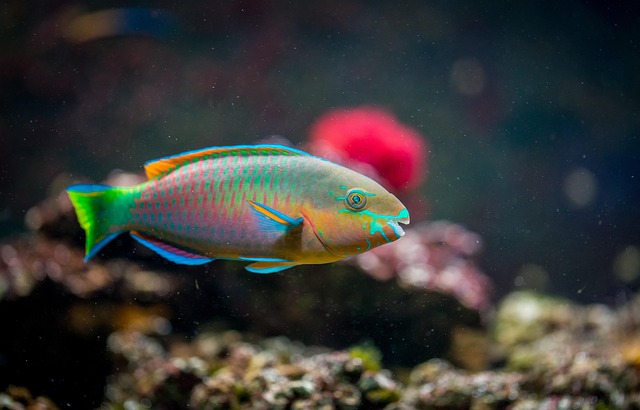Large-scale public aquariums meticulously design habitats to replicate diverse aquatic environments, focusing on water quality, complexity, and natural elements. They balance saltwater and freshwater exhibits, offering educational experiences that highlight biodiversity. Through creative themes and sustainable practices, these aquariums immerse visitors while conserving species and minimizing environmental impact.
In the realm of large-scale public aquariums, showcasing diverse marine life requires meticulous attention to ecosystem requirements. This article delves into the art and science of creating balanced environments, exploring the distinct needs of saltwater and freshwater ecosystems. We examine strategies for tailoring habitats to cater to various visitor expectations while emphasizing sustainable practices essential for long-term success in exhibiting vibrant, bustling aquatic landscapes.
Understanding Ecosystem Requirements for Large-Scale Public Aquariums
Understanding the ecosystem requirements for large-scale public aquariums is paramount in creating thriving marine habitats. These facilities, with their ability to house diverse species from various aquatic environments, demand meticulous planning and execution. The first step involves identifying the specific needs of each organism, ranging from water quality parameters like salinity, temperature, and pH levels to habitat complexity and hiding spots.
Large-scale public aquariums must replicate natural conditions as closely as possible while accounting for the unique demands of different species. This includes designing tanks with suitable substrates, vegetation, and structural elements that mimic their native environments. Additionally, efficient filtration systems are crucial to maintain water quality and control parameters such as nitrate levels, ensuring a healthy and sustainable ecosystem within the aquarium.
Creating Balanced Environments: Saltwater vs Freshwater Exhibits
Creating balanced environments in large-scale public aquariums requires careful consideration between showcasing saltwater and freshwater ecosystems. Each presents unique challenges and opportunities. Saltwater exhibits demand precise temperature, salinity, and oxygen levels to replicate the vast ocean habitats, from coral reefs to deep-sea trenches. Aquarium staff must employ advanced filtration systems and regular water exchanges to maintain these conditions, ensuring the health of diverse species ranging from colorful fish and majestic sharks to delicate corals and intricate invertebrates.
In contrast, freshwater ecosystems offer a spectrum of biomes to explore, from serene rivers and lakes to vibrant wetland habitats. These exhibits require meticulous attention to pH levels, hardness, and nutrient cycling. With proper management, large-scale aquariums can highlight the beauty and biodiversity of freshwater species, including striking fish varieties, playful river dolphins, and majestic sturgeons, providing visitors with an educational and captivating experience that mirrors the complexities of nature.
Tailoring Aquatic Habitats to Specific Visitor Needs
In the realm of large-scale public aquariums, tailoring aquatic habitats to specific visitor needs is an art and a science. These institutions strive to create immersive experiences that cater to diverse interests and learning styles, ensuring every guest can appreciate the wonders of both freshwater and saltwater ecosystems. By segmenting exhibits based on themes like biodiversity, conservation, or regional diversity, aquariums offer unique perspectives that resonate with various audiences.
For instance, a freshwater exhibit might focus on the intricate balance of Amazonian rivers, showcasing the vast array of life thriving in these delicate habitats. In contrast, a saltwater gallery could transport visitors to the depths of the ocean, highlighting the haunting beauty and importance of coral reefs. This tailored approach not only satisfies visitor curiosity but also fosters a deeper understanding and appreciation for the complexity and fragility of our planet’s aquatic ecosystems.
Sustainable Practices in Exhibiting Diverse Marine Life
In the realm of large-scale public aquariums, sustainable practices are crucial for exhibiting diverse marine life. These institutions play a vital role in educating visitors about the intricacies of underwater ecosystems while ensuring the long-term survival of various species. One key approach involves cultivating and breeding marine organisms in controlled environments, utilizing advanced technologies to mimic their natural habitats as closely as possible. This not only reduces the reliance on capturing wild specimens but also allows for the preservation and protection of endangered species.
Additionally, large public aquariums implement innovative recycling systems for water and waste, minimizing environmental impact and maximizing resource efficiency. They employ sophisticated filtration methods, combined with regular monitoring and maintenance, to maintain optimal water quality. These sustainable practices not only contribute to the overall health of marine ecosystems but also foster a sense of stewardship among aquarium visitors, encouraging them to appreciate and protect the delicate balance of our oceans.
Large-scale public aquariums offer a unique opportunity to showcase the beauty and diversity of marine life. By understanding and tailoring ecosystem requirements, aquariums can create balanced environments that cater to both visitors and aquatic species. Through sustainable practices and tailored habitats, these institutions not only entertain but also educate the public about the importance of preserving our oceans. This holistic approach ensures that large-scale public aquariums continue to be vibrant centers for marine research and conservation.
